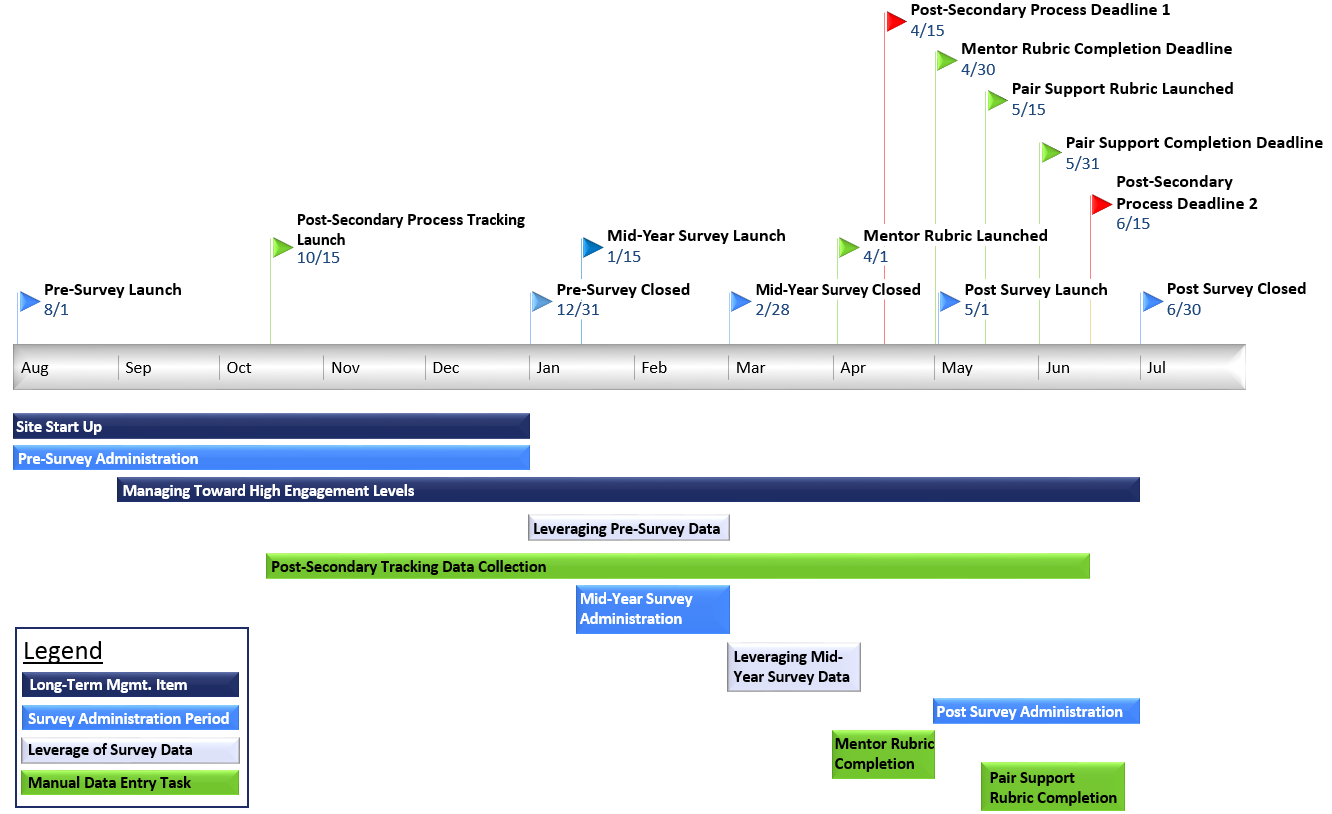Program staff have myriad responsibilities when it comes to collecting and leveraging data throughout the program year. This article outlines those responsibilities in an effort to help focus efforts related to data collection and use amidst other tasks associated with administering the iMentor model.
What, When and Why
The flags in the graphic below show (approximate) key dates for data collection throughout the program year. The bars on the bottom indicate the duration of data collection and use.
Below, each season of the program year is described with more detail.
Fall
The general focus during this time period is successfully launching the program year. With regards to data collection and use, this includes:
- Obtaining rosters and enrolling students in the program, ensuring accuracy of the Mentee Enrollment interface on the iMentor platform;
- This process is critical to ensuring that all students are appropriately categorized so that they are prepared to be matched with a mentor or simply continue their engagement with the program. Click here to learn more about categorizing students using the Mentee Enrollment interface.
- Administering the mentee and mentor pre-survey;
- In order to collect data from program participants to measure pairs' progress toward targeted outcomes, it is critical that the Pre-Survey is completed. Click here to learn more about mentee and mentor surveys.
- In the case of continuing cohorts, it is also a best practice to request the results of the previous year's post-survey in order to understand where pairs are in their relationship and progress toward outcomes. Click here to request survey results from the Research and Evaluation (RE) team.
- Establish healthy engagement habits early;
- RE has conducted research that associates strong personal relationships with program engagement benchmarks. As such, it is important to ensure high levels of engagement between mentees and mentors.
- The practice of managing to high levels of engagement is an effort that continues throughout the program year. Establishing the habit of doing so early will set pairs up for successful relationships and theoretically make management toward pair engagement easier over time. The platform has two main resources to aid in this effort: Snapshot and S.T.E.V.E.
- Staff responsible for supporting senior pairs begin collecting information regarding navigation of the post-secondary process;
- The ultimate outcome of iMentor's program is college success. It is important to track mentees' progress through the discrete tasks necessary to get to college to ensure they are on pace to meet this goal.
Click here to learn about the leadership tasks associated with the fall season.
Winter
Once the program is launched, the primary objectives for the winter season are reinforcing healthy engagement habits and ensuring pairs are establishing strong personal relationships.
- Using pre-survey data to obtain a baseline understanding of where mentees and mentors are in their relationship and their progress toward outcomes;
- The pre-survey is quite lengthy and the data it generates can often be intimidating. However, limiting the scope of what is considered is an easy way to break the task into manageable chunks (i.e., Learn what mentees and mentors saying about trust in their relationship and consider how you can intervene when there is a lack of trust.)
- The mid-year survey is also conducted during the winter. This survey is much shorter than the pre and post surveys and is designed less for research and more for program staff to check in on pairs' progress since the pre-survey.
- Leveraging pair engagement data trends via Tableau is a great way to identify areas where additional focus and/or support is necessary to ensure high levels of communication between pairs in service of working toward the goals of the program.
Click here to learn about the leadership tasks associated with the winter season.
Spring
As the end of the program year approaches, the focus areas during Spring continuing to foster high levels of engagement, setting pairs up for a successful transition into the next year of programming or supporting them through a healthy closure process and reflecting on the year to date.
- As previously mentioned, driving high levels of pair interaction is a year long process and continues through the spring;
- During the spring, reflection takes several forms:
- Program staff consider their mentors' effectiveness in developing a relationship with their mentee and leverage of curricula via the Mentor Quality Rubric. This process allows us to evaluate the strength of our mentor population at large, but also aides in the process of preparing for effective and fruitful end of year calls with mentors.
- Managers consider the effectiveness of the program staff they manage using the Pair Support Quality Rubric. This process allows us to evaluate areas where program staff are successful and where there is room for growth. Additionally, managers can leverage this process to begin forming thoughtful performance evaluations.
- Mentees and mentors reflect on the year through completion of the end of year survey. This data is compared to that of previous administrations and allows for thorough analysis of program effectiveness with regard to targeted outcomes. Additionally, this data can serve as a great way to determine where pairs are in their relationship and progress toward programmatic goals at the beginning of the following program year.
Click here to learn about the leadership tasks associated with the winter season.
Still have questions?
Reach out to [email protected]. The team is more than happy to address any questions, comments or concerns you may have!


